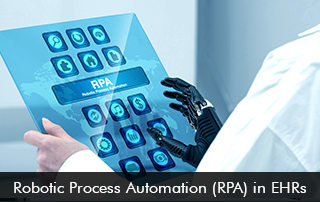Robotic Process Automation (RPA), a development in the rapidly changing field of healthcare technology, has been quietly transforming the way healthcare organizations handle their operations and patient data. Although RPA is frequently linked to sectors like finance and manufacturing, it has discovered a promising application in the field of electronic health records (EHR). In this article, we examine the substantial effects of RPA on EHR systems, emphasizing how this technology is improving patient care, streamlining administrative duties, and boosting operational effectiveness.
What is Robotic Process Automation (RPA)?
RPA stands for robotic process automation, which is the use of software “bots” to automate routine, rule-based tasks and procedures. These bots replicate human behavior while interacting with computer systems and adhere to set procedures. RPA is intended to increase productivity, decrease errors, and release human workers from routine tasks so they may concentrate on more difficult and valuable projects.
The RPA-EHR Synergy:
-
Streamlining Administrative Tasks
The sphere of administrative duties related to Electronic Health Records is one of the key areas where RPA excels inside the healthcare ecosystem. RPA allows tasks that traditionally required hours of manual labor to be completed quickly and precisely. This is how:
-
Effortless Data Entry and Migration
RPA can automatically fill EHR systems with patient data by extracting it from a variety of sources, including paper documents and online forms. This expedites the switch to electronic records while simultaneously lowering the possibility of transcribing errors.
-
Automated Appointment Scheduling and Reminders:
RPA bots can handle appointment scheduling, remind patients to keep their appointments, and even reschedule them in accordance with pre-established rules. As a result, provider schedules are improved and no-show rates are decreased.
-
Claims Processing and Billing Precision:
By validating insurance information, submitting claims, and handling payments, RPA automates the claims processing and billing cycle. As a result, the billing process is more precise and effective, which is advantageous for both patients and healthcare providers.
-
Streamlined Document Management:
RPA streamlines document categorization and organization inside EHR systems, enabling quick document retrieval. Better data organization and administration are benefits of this.
Elevating Patient Care through RPA-Driven EHR
Beyond administrative tasks, RPA plays a pivotal role in enhancing patient care through more streamlined processes and improved data accuracy:
-
Prompt Medication Reconciliation:
By comparing pharmacy data with patient records, RPA supports medication reconciliation by lowering the possibility of medication errors and enhancing patient safety.
-
Efficient Handling of Lab Test Results:
Incoming lab test results are processed by RPA, which also updates patient data and notifies healthcare practitioners of any unusual discoveries. This expedites action and improves clinical judgment.
-
Data Validation and Cleanup:
RPA automates data validation tests, finds discrepancies in patient records, and fixes them. This promotes improved clinical results and ensures data integrity.
Future Horizons: RPA’s Role in Interoperability and Beyond
RPA is ideally positioned to play a big role as healthcare looks for increased interoperability. RPA makes it possible for EHR systems and other healthcare applications to seamlessly share data, which improves communication and information sharing. Additionally, RPA has the ability to be used for complex activities including creating routine reports, performing data analytics, and supporting predictive modelling.
-
Enhanced Data Sharing:
Healthcare practitioners can access thorough patient information from any source thanks to RPA’s ability to streamline data interchange between various EHR systems. This encourages more coordinated treatment and better-informed clinical decisions.
-
Interconnected Healthcare Ecosystem:
RPA opens the door for a more integrated healthcare ecosystem by bridging the gap between various healthcare apps and systems. It facilitates the connection of EHRs to additional technologies including telemedicine platforms, wearables, and health monitoring equipment.
-
Standardized Workflows:
RPA can aid in the standardization of workflows by automating operations involving data transfers between systems. This guarantees accuracy, minimizes mistakes, and raises the general standard of patient records.
-
Real-Time Data Syncing:
Updates made in one EHR system can be promptly reflected in other EHR systems thanks to RPA’s real-time syncing capabilities, encouraging accurate and current patient information throughout the care continuum.
-
Multi-Platform Communication:
RPA can ease communication between various EHR platforms, facilitating collaboration on patient care plans and secure information sharing among healthcare providers.
-
Data Aggregation for Analytics:
A holistic perspective of patient populations can be obtained by RPA-driven data aggregation from several EHR systems, which helps with population health management, trend analysis, and predictive modelling.
-
Support for Research and Clinical Trials:
In order to assist research institutes in collecting data for clinical studies and trials, RPA can automate the extraction and consolidation of patient data from various EHR systems.
RPA can work in conjunction with AI algorithms and sophisticated analytics tools to further enhance the conclusions obtained from integrated EHR data and to provide predictions of patient outcomes.
-
Reduced Administrative Burden:
RPA’s contribution to interoperability extends to administrative duties such as insurance verification and claim processing, resulting in a more simplified experience for both healthcare professionals and patients.
-
Global Healthcare Connectivity:
RPA has the potential to facilitate interoperability across borders, allowing for cross-border data sharing and boosting international collaboration in patient care and medical research.







